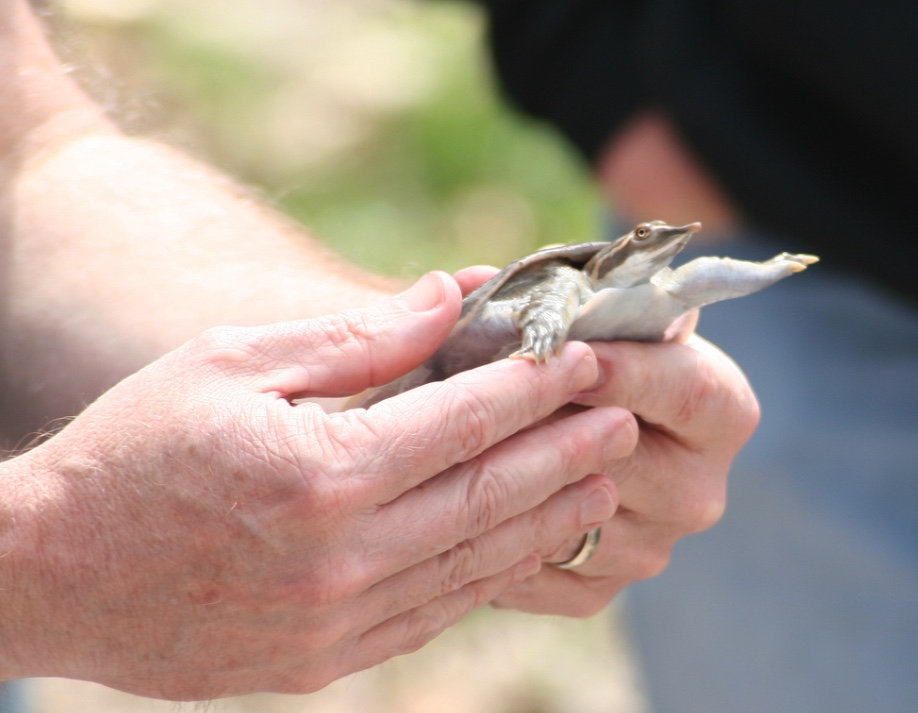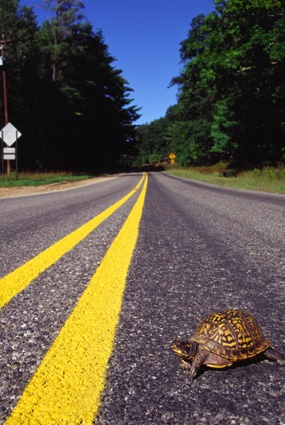
Photo: Doug Mills
The photo gallery on this page provides information about several of the turtles that are found in Illinois. Additionally, the Prairie Research Institute’s Illinois Natural History Survey has an Illinois Species page to help people figure out what species turtle they have found. If you don’t know what the species is, click on the text to work through the key. If you see a photo that looks like the species you saw, then you can click on the photo to get information about that particular species.
Aquatic and terrestrial turtles can encounter a number of hazardous situations in Illinois’ human-dominated landscapes. Turtles may be mauled by domestic pets or mishandled by curious children and adults. Many are crushed by vehicles while they are crossing roads. Female turtles are often struck while searching for nest sites during the spring and summer months, and turtles of all ages and both sexes are struck when they migrate between water sources during the late summer and fall. Additionally, curbs along roads and parking lots and railroad tracks can trap turtles.
Female aquatic turtles and box turtles may nest in mulch and flowerbeds. They also nest in exposed sand or soil in yards, along railroad tracks and trails edges, in agricultural fields, and in crushed limestone trails, especially if these areas are near permanent water.
It is best to allow turtle eggs to incubate and hatch (60 to 90 days depending on the turtle species) where the female laid them. Placing a wire basket (with a top) over the nest site can protect the nest from predators such as raccoons and opossums.
Unless a turtle is in immediate danger, leave it where you found it. Consider human safety first and use good judgment when attempting to move a turtle, especially off of a road. If you must move the turtle, don’t move it far. And always wash your hands with hot water and soap afterward.
If a turtle must be moved, there are several steps that you should take to minimize impacts on the turtle. Smaller turtles can be lifted safely with one or two hands from the back (tail end) of the shell. Firmly grasp the shell from the top and bottom of the shell with the fingers and lift the turtle. Be careful not to be scratched by the nails on the turtle’s hind feet. Place the turtle in a container or box.
If you would rather not come into contact with the turtle, gently slide a broad, flat shovel under the turtle and place it into a container. It is not necessary to provide water as long as the turtle will be held only a short time. It is important to get the turtle back in the wild as soon as possible.
Female turtles searching for nest sites are often found crossing roads. These females may expel a large amount of water from their vent/cloaca when lifted up by a well- meaning rescuer. This water is important for moistening the soil of the nest site. If a female expels water, it is best to return her to the closest area near standing water. If the rescuer cannot find water nearby, and the female turtle has released water, the turtle should be placed in a container of shallow water for a couple of hours before being released. Do not move the turtle very far from where it was found.
Take special care when moving snapping turtles. Snapping turtles can be dangerous for an inexperienced person to handle. If you must handle a snapping turtle, always keep your hands on the hind legs or on the very rear portion of its shell. The long tail of a snapping turtle should not be used to lift the turtle, since the weight of the body can sever the turtle’s spine. It is best to grab the snapping turtle by its hind legs (one in each hand) and use them as handles.
If you have questions about reptiles or amphibians in Illinois, you can contact Scott Ballard, Illinois Department of Natural Resources, Southern Region Endangered and Threatened Recovery Species Specialist/Herpetologist, at Scott.Ballard@Illinois.gov or 618-694-3398.
The Prairie Research Institute’s Illinois Natural History Survey provides species distribution maps and more natural history information.

Photo: Mike Redmer
Photo: Dr. E. O. Moll
Photo: Dr. E. O. Moll
Photo: Scott Ballard
Photo: Dr. E. O. Moll
There are three subspecies recognized in the United States, but only the red-eared slider (Trachemys scripta elegans) is found in Illinois.
Dr. E. O. Moll
Photo: Dr. E. O. Moll
Photo: Dr. E. O. Moll
Photo: Scott Ballard
The Wildlife Illinois website was authorized by the Illinois Department of Natural Resources (IDNR) in partial fulfillment of project W-147-T. The website was developed by the National Great Rivers Research and Education Center, 2wav, and the IDNR in partnership with the United States Department of Agriculture Animal and Plant Health Inspection Service Wildlife Services and University of Illinois Extension to provide research-based information about how to coexist with Illinois wildlife.